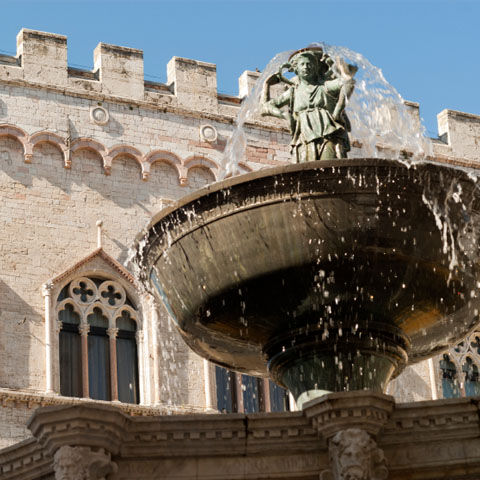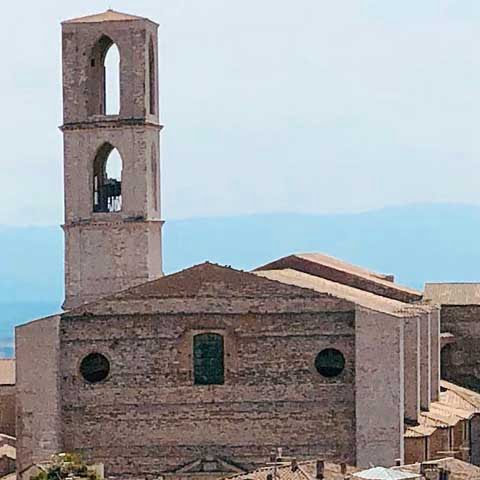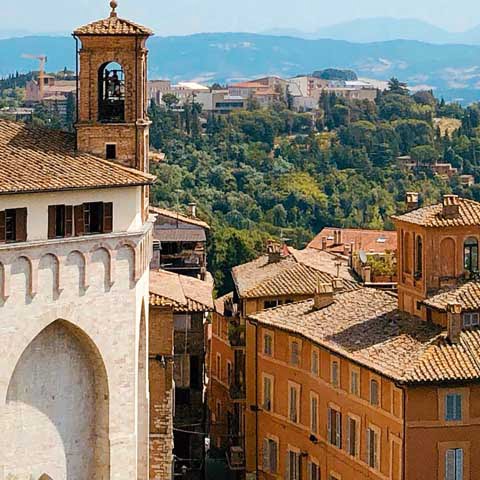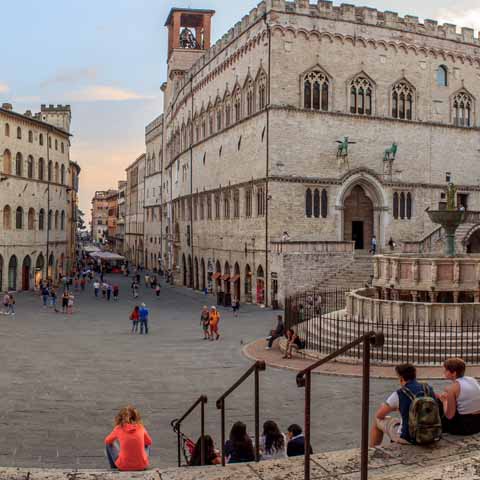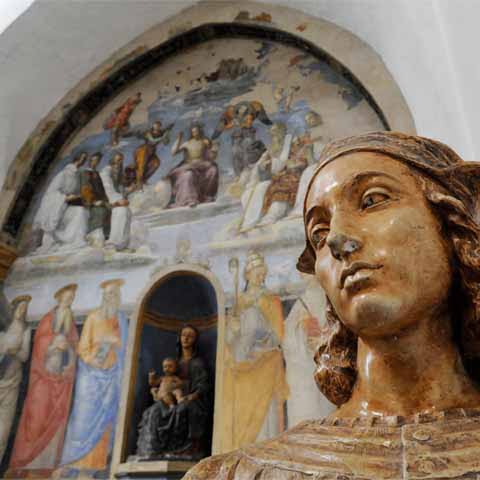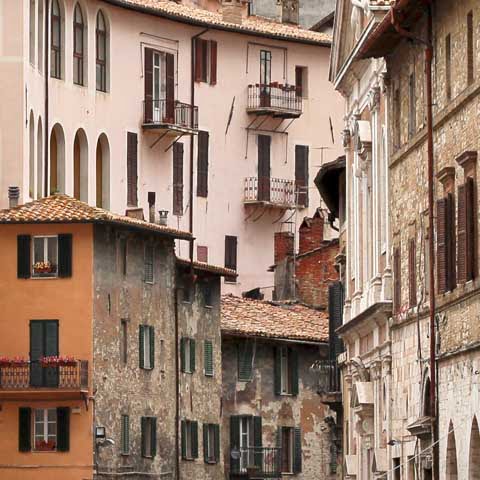The homeland of artists and eclectic souls, Perugia is one of the most fascinating cities in Italy. It is the capital of the homonymous province in the Umbria region and the birthplace of illustrious personalities, including Pietro Perugino, Gerardo Dottori, and Vincenzo Danti, to name just a few.
Besides its important cultural heritage, Perugia also boasts a rich history and preserves important monuments from various eras.
The cultural, productive, and economic center of the region, this city is also an important travel destination.
Human life here began with the Umbrian settlements – more or less like most other cities and towns in the region, but the actual foundation of the city is believed to have Etruscan origins. Indeed, even the name was established by the Etruscans, though the city was called Perusna in the era.
The original city is still visible today in many points of the city center, especially near Colle Landone and Colle del Sole, where you can admire the remains of the acropolis. Furthermore, the large Old Town also preserves much of its Etruscan heritage.
Perugia is asymmetrically laid out on a series of hills a short distance from the Tiber River. Besides the ancient heritage, the city also maintains most of its medieval charm and presents an impressive architectural continuity between the older and the newer boroughs.
Known as the city of chocolate, Perugia is also an important university center and a diocese.
PREHISTORY OF PERUGIA
The first traces of human settlements in the territory of Perugia date back to the eleventh century BC, when a few Villanovan villages stretched across the slopes of the hills surrounding today’s city. Perhaps the first founding of the city dates back to the eighth century BC when a small village was established atop a hill where one can now admire Perugia’s historical center.
The closeness to the Tiber river and its position on the border between the Umbrian and Etruscan populations influenced the rapid development of this first settlement.
According to remains from the time, the Umbri were the first to settle in the area, but the Etruscans slowly gained control over this first village. While a war between the Umbri and Etruscans is unlikely, it is believed the latter found opportunities to establish their control due to the trade relations the two civilizations exchanged.
The arrival of the Etruscans in Perugia can also be described as positive. In fact, the real urban nucleus of today’s city was founded around the sixth century BC by the Etruscans. Some of the remains from the era include a necropolis.
The Romans first arrived here between 310 and 309 BC, but Perugia quickly formed a league with the other Etruscan cities in the area, defeating the Roman intrusion. At the end of the battle, the Romans agreed to sign a 30-year truce, but this pact was not respected.
Nevertheless, the Etruscans still managed to build new city walls in the third century BC, parts of which are still visible today.
Only 14 years after the signing of the treaty, the Romans gained control over Perugia in 295 BC. However, they allowed the people to retain Etruscan as an official language as well as a limited municipal autonomy. Thanks to these concessions, the locals proved themselves faithful to Rome during the Second Punic War, providing shelter to the Roman army after their tragic defeat in 217 BC.
Following the Social War in the first century BC, Perugia was fully integrated into the Roman state and was granted Roman citizenship in 89 BC.
The first Roman stylistic features in the region started to appear around the same year; however, it was a fire in 41 BC that favored the remodeling of the city according to the Roman style, despite the substantial permanence of the Etruscan road structure.
A true urban revival was also favored by Augustus, who returned the ancient splendor to the city while also expanding it. During the Imperial Age, the city expanded beyond the Etruscan walls and received an amphitheater and a new temple of Mars.
One of the most important archaeological remains from the era includes a beautiful mosaic of Orpheus believed to have been part of the public baths.
This period of wealth and economic growth ended in the fourth century AD due to the barbarian invasions and the fall of the Western Roman Empire.
HISTORY OF PERUGIA
Relatively anonymous throughout prehistory – despite its importance as a trade center – Perugia gained considerable weight on the historical scene during the Gothic wars, becoming the most important city in Tuscia, the Roman name for Etruria.
In 493, the city was conquered by the Ostrogoth troops and in 535 passed under the rule of Justinian I, Emperor of the Byzantine Empire.
The Goths did not receive the defeat well and fought the Byzantines, regaining control of the city in 548. However, only five years after, the death of the Ostrogoth king saw Perugia reunited once again with the Byzantines, where it remained until the eighth century.
The rise of the Papal States and the Carolingian Empire brought change to the city. Under the influence of the church, Perugia gained numerous churches, as well as laic edifices, including the stunning Cathedral of San Lorenzo, erected in 936.
In 1139, a government made up of various consuls resulted in the birth of the municipality, an autonomous form of government with the power divided between the consuls, a general assembly of the citizens, and a minor council.
Following the proclamation of the municipality, the council changed the name of Piazza San Lorenzo to Piazza del Comune, and in the second half of the twelfth century, Perugia gained influence over the surrounding countryside.
The municipality agreed to a peace treaty with Henry VI, and the consular government gained diplomatic recognition in its foreign affairs. Nevertheless, in 1198, the council accepted the protection offered by Pope Innocent III, whose real intent was to form a state in the territory.
Under the new rule, Perugia gained new imperial recognition and strengthened its force. On various occasions, the city offered refuge to the popes hiding from the riots in Rome and became home to five conclaves, including those that led to the election of Honorius III, Clement IV, Celestino V, and Clement V.
The papal presence was beneficial for internal peace, preventing rivalries between the nobles. And even if the city never accepted the papal sovereignty, it still enjoyed peace and growth under the wing of the church.
This tranquil period ended in 1282, however, when the city was excommunicated due to its actions against the Ghibellines.
In the thirteenth century, the municipality implemented a new expansionist policy, increasing its power and gaining control over Assisi, Montone, and Gualdo Tadino.
Between the thirteenth and fourteenth centuries, the municipality experienced impressive urban development, including the construction of Fontana Maggiore. In 1308, the University of Perugia was founded in Palazzo dei Priori.
The presence of the Anjou in Italy offered Perugia an alternative to papal rule, and in 1319, the city elected Ludwig of Anjou as lawyer and governor of the municipality, with the purpose of eliminating the need to depend on either the papacy or the empire.
However, the arrival of the Plague in 1348 weakened the city’s defensive system, and in 1370, pope Urban V regained control of Perugia.
The consequent restoration of the authority of the church not only in Umbria but also in Lazio, Emilia-Romagna, and Marche determined a slow but gradual limitation of Perugia’s autonomy, but without preventing the emergence of the lordships.
In 1393, Captain Biordo Michelotti became the Knight of the People appointed by the General Council, as well as the General Captain of the Militia. During his rule, Michelotti focused on exiling numerous nobles, and he was ultimately appointed as the first Lord of Perugia.
His lordship ended tragically, and after Michelotti’s murder, the Lordship of Perugia fell under the influence of Gian Galeazzo Visconti, the Duke of Milan. Visconti’s original purpose was to create a central-northern unitary state, but this idea would vanish with his death in 1402 when the government of the city was offered to Pope Boniface IX.
Again under the rule of the church, the municipality of Perugia was appointed under the domination of the Michelotti family and then passed to the Montone dynasty.
During the reign of the Montone, the city received important public works such as new residential buildings near the main square.
Between 1438 and 1479, the Baglioni family exercised a form of occult lordship over Perugia, which was not characterized by the total control of the civic power. In this time, however, the Palazzo dei Priori was enlarged, and the city gained numerous churches, private chapels, and other architectural and artistic works.
Perugia quickly became the main center of the Umbrian Renaissance, some of the most important works of the era, including the eight tables of the Stories of San Bernardino and other important frescoes were completed throughout the city.
The Baglioni family also commissioned important architectural works, most of these mansions serving as private residences for the family – some of them are today incorporated into the Rocca Paolina, a fortress decorated by Domenico Veneziano with a cycle of paintings representing the noble families of Perugia and some of the greatest leaders of the past.
Perugia lost its centenary civic freedom and autonomy in 1540 when, during the so-called Salt War, the city passed again under the direct administration of the Papal States. One of the first rules established by the clergy was the erection of Rocca Paolina, an imposing defensive structure controlled by a papal garrison.
The Papal State ruled Perugia from the mid-sixteenth century until the annexation of Umbria to the Kingdom of Italy in 1860.
During this time, the city experienced a period of demographic stagnation and economic decline, similar to all other papal provinces.
Things were different from an artistic and architectural point of view however; throughout this period, Perugia continued to be enriched with new prestigious buildings, baroque-style churches, and numerous works of art.
After the fall of the Papal States in 1849, Perugia allied with Napoleon III, the Emperor of France, to free itself completely from the power of the popes.
On November 4, 1860, together with the rest of Umbria and the Marche region, Perugia was annexed to the nascent Kingdom of Italy.
After the unification, the city became a privileged capital of the vast homonymous province and, subsequently, the capital of the entire Umbria region.
As one of the most important cities in central Italy, Perugia played an important role during both World Wars.
Today, Perugia is one of the most beautiful medieval cities in Italy and Europe as well as an important industrial center, especially in the manufacture of sweets and chocolate.
ARCHAEOLOGY OF PERUGIA
Among the main archaeological areas in Perugia, perhaps the most important is the Necropolis of Monteluce, a Roman-era necropolis dated back to the sixth century BC. The materials found here include a few Greek artifacts, Etruscan pottery, as well as bronzes and ceramics belonging to the Roman civilization.
Another important site is the Roman funerary monument near Via del Giochetto, essentially a tomb decorated with funerary lions at the corners, one of which is now located above the gate of a building in Via Enrico dal Pozzo.
The Hellenistic necropolis is another noteworthy site to visit if you are interested in archaeology. This monumental area includes the famous Tomb of the Rafi discovered in 1887, a sepulchral place full of urns and other artifacts.
In the vicinity of the modern cemetery, you can also observe a Roman milestone that marked the first mile of distance from Perugia’s original city center.
Last but not least, particularly important is also the Etruscan hypogea of Casaglia that contains not only artifacts from the Etruscan era but also many objects dated back to the Hellenistic era.
Important collections of artifacts discovered in the region are now exhibited at the National Museum of Archaeology in Perugia.
Travel Guides
The Umbria Region of Italy
The Cities of Umbria, Italy
